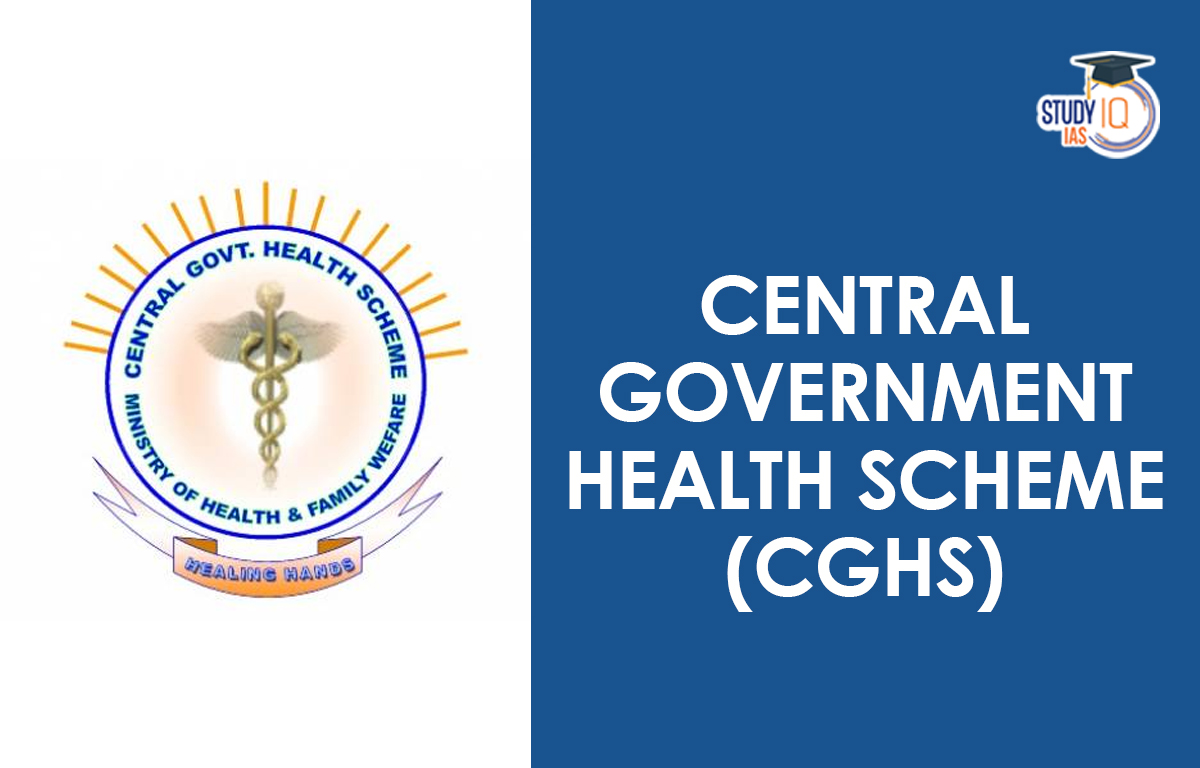Table of Contents
Context: The Union Health Ministry has proposed a revision of the Central Government Health Scheme (CGHS) package rates for all beneficiaries in India in a response to stakeholder demands and increasing healthcare costs. This move may have implications for the larger healthcare landscape in India.
What is Central Government Health Scheme (CGHS)
It is a comprehensive healthcare scheme provided by the Indian Government to its employees, pensioners, and their dependents. It was established in 1954 with the aim of providing quality healthcare services to government employees and their families.
- The scheme is unique in its approach of providing open-ended and generous health care services to its beneficiaries. CGHS is the model healthcare facility provider for Central Government employees and pensioners, covering all four pillars of the democratic set up in India- Legislature, Judiciary, Executive, and Press.
- The scheme is known for its wide range of healthcare services that cover various systems of medicine, including allopathic, homeopathic, and Indian systems of medicine such as Ayurveda, Unani, Siddha, and Yoga.
- As of 2022, the scheme covers approximately 41 lakh beneficiaries in 75 cities all over India. The scheme is administered by the Ministry of Health and Family Welfare and is one of the largest healthcare programs in India. It plays a crucial role in providing affordable and accessible healthcare to the beneficiaries.

Facilities available under CGHS: The Central Government Health Scheme (CGHS) provides a range of healthcare facilities to eligible beneficiaries. These facilities are designed to cater to the diverse healthcare needs of Central Government employees, pensioners, and their dependents.
- OPD Treatment and Specialist Consultation: The CGHS provides outpatient department (OPD) treatment at its wellness centres, which includes the issuance of medicines. Specialist consultation is also available at polyclinics, government hospitals, and CGHS empanelled hospitals. However, a referral from CGHS is necessary to avail of these services.
- OPD and Inpatient Treatment: The scheme provides OPD and inpatient treatment at government and empanelled hospitals. This includes cashless treatment facilities for pensioners and identified beneficiaries in empanelled hospitals and diagnostic centres.
- Investigations and Reimbursement: The CGHS also facilitates investigations at government and empanelled diagnostic centres. In case of an emergency, beneficiaries can avail reimbursement for treatment expenses incurred in government or private hospitals, subject to endorsement by the CMO/MO of wellness centres.
- Other Medical Facilities: The scheme also provides reimbursement for expenses incurred for the purchase of hearing aids, artificial limbs, and appliances after obtaining permission. Maternity and child health services, family welfare, and medical consultation are also available under the CGHS. Additionally, the dispensing of medicines in Ayurveda, Homeopathy, Unani, and Siddha system of medicines (AYUSH) is also a part of the CGHS services.
Recent Changes in CGHS: The Package Rates to the beneficiaries of CGHS have been revised for the first time since 2014, these changes include the following:
- The revision of the CGHS package rates includes an increase in the rates of consultation fees and hospital room rent. The Out-Patient Department (OPD) rates have been increased to Rs. 350 from Rs. 150, and the In-Patient Department (IPD) consultation fee has seen a Rs. 50 rise to Rs. 350. The Intensive Care Unit (ICU) services have been fixed at Rs. 5,400, including accommodation for all ward entitlements.
- Hospital room rent has also been revised. The rent for a general room has been fixed at Rs. 1,500 from Rs. 1,000 earlier, a semi-private ward has been increased to Rs. 3,000 from Rs. 2,000 earlier, while the rate of a private room has been increased from Rs. 3,000 to Rs. 4,500.
- The revised rates are expected to lead to an additional expense ranging from Rs. 240 crore to Rs. 300 crore for the government.
- Referral process has been simplified and made more accessible, under the revised CGHS Package a medical officer can refer the beneficiary to a hospital after checking the documents. A CGHS beneficiary can also get a referral through a video call
Implications of Revised CGHS Rates on Healthcare in India: The recent decision by the Union Health Ministry to revise the Central Government Health Scheme (CGHS) package rates and simplify the referral process is expected to have significant implications for healthcare in India.
Increased Healthcare Costs
- The revision of CGHS package rates, including the increase in consultation fees, ICU charges, and room rent, is likely to result in increased healthcare costs for beneficiaries. While the revised rates are aimed at covering the rising costs of healthcare services, the move may affect the affordability of healthcare for some.
Additional Government Expenses
- The revision of CGHS rates will also result in additional expenses for the government, ranging from Rs 240 crore to Rs 300 crore. This could put a strain on the government’s healthcare budget and limit the resources available for other health programs and initiatives.
Improved Access to Healthcare Services
- The simplified referral process under the CGHS is expected to improve access to healthcare services for beneficiaries. The earlier requirement of visiting the CGHS Wellness Centre in person to be referred to a hospital could be a significant barrier to accessing healthcare for some beneficiaries. The simplified referral process will make it easier for beneficiaries to get referred to a hospital, even if they are unable to visit the Wellness Centre in person.
Enhanced Efficiency of CGHS
- The simplified referral process is also expected to enhance the efficiency of CGHS. The previous referral process was time-consuming and involved multiple steps, resulting in delays and inconvenience for beneficiaries. The simplified process is likely to reduce the time and effort required for referrals, making the system more efficient.
Improved Healthcare Delivery
- The revision of CGHS rates and the simplified referral process could lead to an improvement in the delivery of healthcare services in India. The increased package rates may lead to improved infrastructure and quality of care in hospitals, while the simplified referral process may lead to increased utilization of healthcare services by beneficiaries.
Health Insurance Schemes in India: Healthcare costs in India have been on the rise, making it difficult for people to afford quality medical care. In response to this challenge, the Indian government has introduced various health insurance schemes to provide financial protection to citizens against high medical expenses.
Pradhan Mantri Jan Arogya Yojana (PMJAY):
- Launched in 2018, PMJAY is one of the largest health insurance schemes in Indi as the tertiary care arm of Ayushman Bharat. It provides an insurance cover of up to INR 5 lakh per family per year for secondary and tertiary hospitalization care. The scheme covers over 10 crore families belonging to the economically weaker sections of society.
Central Government Health Scheme (CGHS):
- CGHS is a health insurance scheme launched by the Indian government in 1954. It provides healthcare services to government employees and pensioners, covering all four pillars of the democratic setup in India, namely Legislature, Judiciary, Executive, and Press. The scheme covers allopathic, homeopathic, Indian systems of medicine (Ayurveda, Unani, Siddha, and Yoga), and dental treatment.
Employment-Based Health Insurance:
- Many employers in India provide health insurance to their employees as a part of their employee benefits package. These policies usually cover the employee, their spouse, and dependent children. The premium is usually borne by the employer, and the coverage amount varies based on the company’s policy.
State Government Health Insurance Schemes:
- Apart from PMJAY and CGHS, several state governments have also launched their own health insurance schemes to provide financial protection to their citizens. For example, the Arogyasri Health Care Trust in Andhra Pradesh provides free medical treatment to citizens below the poverty line, while the Bhamashah Swasthya Bima Yojana in Rajasthan covers families with an annual income of up to INR 2.5 lakh.
Loopholes in present CGHS: addressing the uncovered population and ignored segment: The Central Government Health Scheme (CGHS) has been a crucial player in providing affordable healthcare to government employees and pensioners in India. However, the scheme has several loopholes that leave a significant section of the population without adequate healthcare coverage.
- Uncovered population: The missing middle class in India is the section of the population that has the ability to pay nominal premiums for healthcare but is not covered under any low-cost health insurance product. This segment is largely ignored by most health insurance schemes in India, including CGHS. As a result, the missing middle remains uncovered, even though they have the financial means to pay for healthcare.
- Ignored segment: While CGHS primarily caters to government employees and pensioners, several other sections of the population remain underserved. For example, private sector employees, self-employed individuals, and those working in the informal sector do not have access to the scheme. This segment is largely ignored by most health insurance schemes and products in the Indian market, including CGHS.
- Affordable goes to BPL: Contributory health insurance products, such as the Employees’ State Insurance Corporation (ESIC) and government-subsidized insurance, including the Pradhan Mantri Jan Arogya Yojana (PMJAY), are affordable options for healthcare coverage. However, these schemes are closed products and not available to the general population due to the risk of adverse selection. As a result, the general population remains excluded from the benefits of these affordable contributory products.
Way Forward
- The Central Government Health Scheme (CGHS) has been catering to the healthcare needs of eligible beneficiaries in India for decades. However, to achieve Universal Health Coverage (UHC) in India, there is a need to address some of the challenges and loopholes in the present CGHS. Here are some suggestions for the way forward:
Enhancement of Health Expenditure:
- To ensure that everyone has access to quality healthcare, India needs to increase its health expenditure. Currently, India spends only 3.2% of its GDP on health, which is lower than the average spending of Lower and Middle Income Countries (LMICs). Therefore, the government needs to increase its health expenditure and allocate more resources to build a strong healthcare infrastructure. The primary healthcare sector, in particular, needs special attention as it is the first point of contact for most people seeking healthcare services.
Review and Rationalize Package Rates:
- It is essential to review and rationalize the package rates to ensure that the increased rates are justified and reasonable. This would require a comprehensive analysis of the cost of providing healthcare services and the actual expenses incurred by the government. This would also help in identifying any inefficiencies or areas where cost-cutting measures can be implemented.
Promote Preventive Healthcare:
- The government should focus on promoting preventive healthcare measures such as vaccination programs, health education campaigns, and lifestyle interventions. This would help in reducing the burden of disease and contain healthcare costs.
Foster Public-Private Partnerships:
- The government should foster public-private partnerships to leverage the strengths of both sectors and improve the quality and accessibility of healthcare services. Private healthcare providers can help in augmenting the existing healthcare infrastructure and provide high-quality healthcare services to the beneficiaries.
Expand Health Insurance Coverage:
- To make healthcare more affordable and reduce out-of-pocket expenses, the government should work towards expanding health insurance coverage to all citizens. The Ayushman Bharat scheme, launched in 2018, aims to provide health insurance cover to vulnerable families. However, the growth in this regard needs to be improved.
Prioritize Primary Healthcare:
- Strengthening primary healthcare is crucial for achieving UHC. This includes increasing access to primary healthcare facilities, improving the quality of care, and strengthening the primary healthcare workforce. The government needs to prioritize primary healthcare and ensure that it is accessible to everyone.
Conclusion
- While CGHS and other health insurance schemes in India have made significant strides in providing healthcare coverage, several loopholes remain that leave a significant section of the population without adequate healthcare. To address these loopholes, there is a need to design health insurance products that cater to the missing middle and other underserved sections of the population. Additionally, efforts need to be made to make affordable healthcare products accessible to a larger segment of the population.


 Industrial Parks in India: Driving Manuf...
Industrial Parks in India: Driving Manuf...
 National Maritime Heritage Complex (NMHC...
National Maritime Heritage Complex (NMHC...
 Reforming Fertiliser Subsidy in India: N...
Reforming Fertiliser Subsidy in India: N...

























